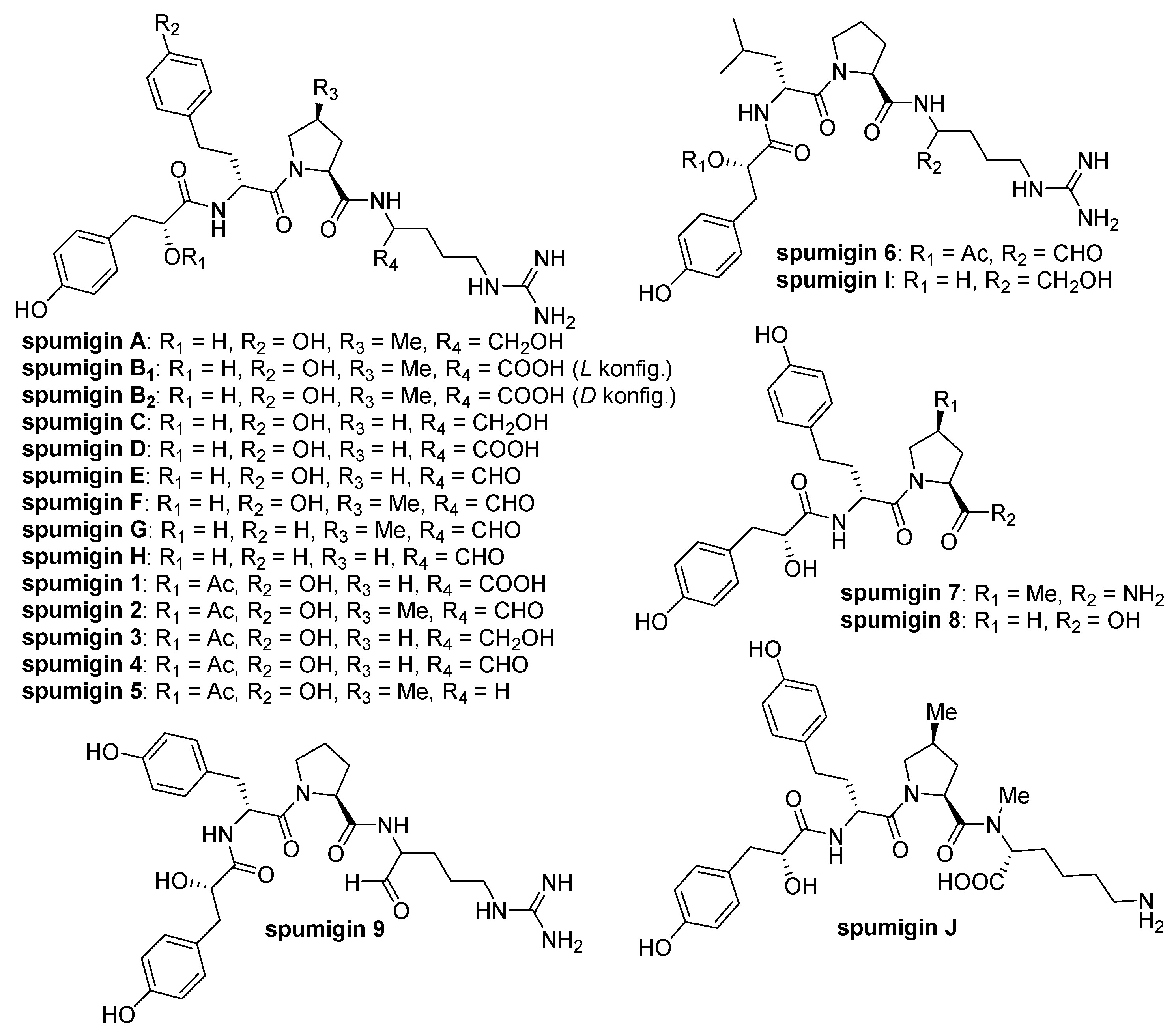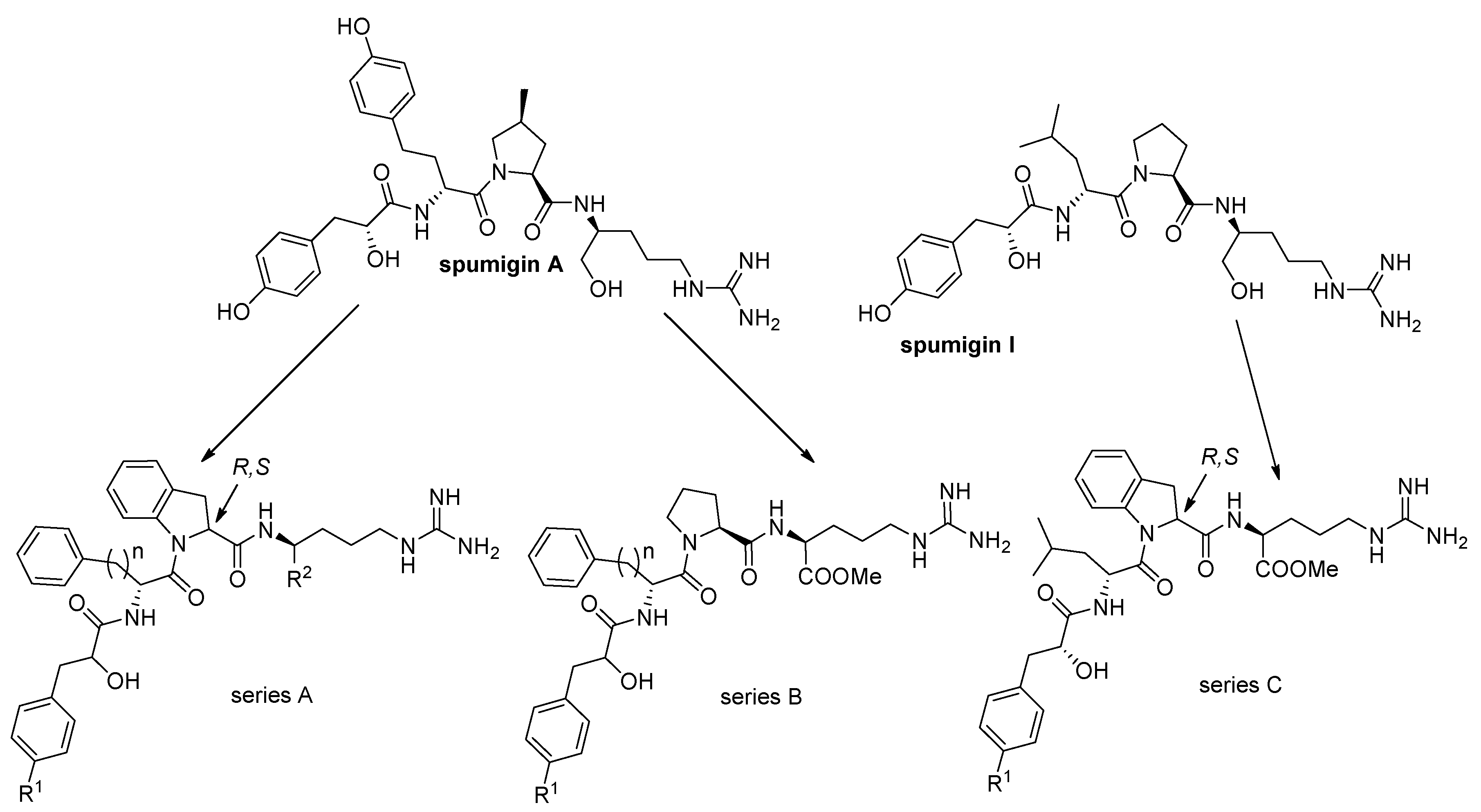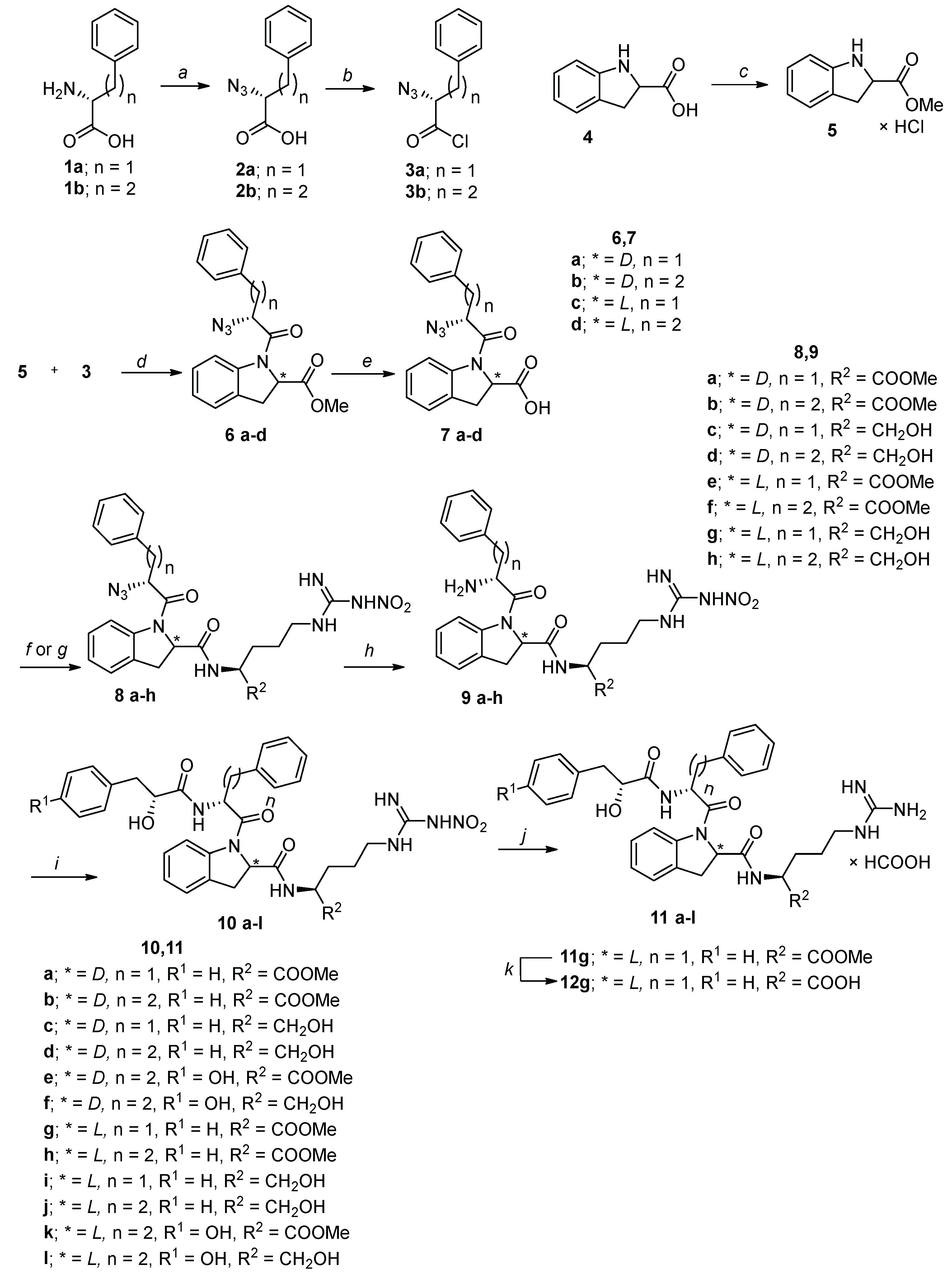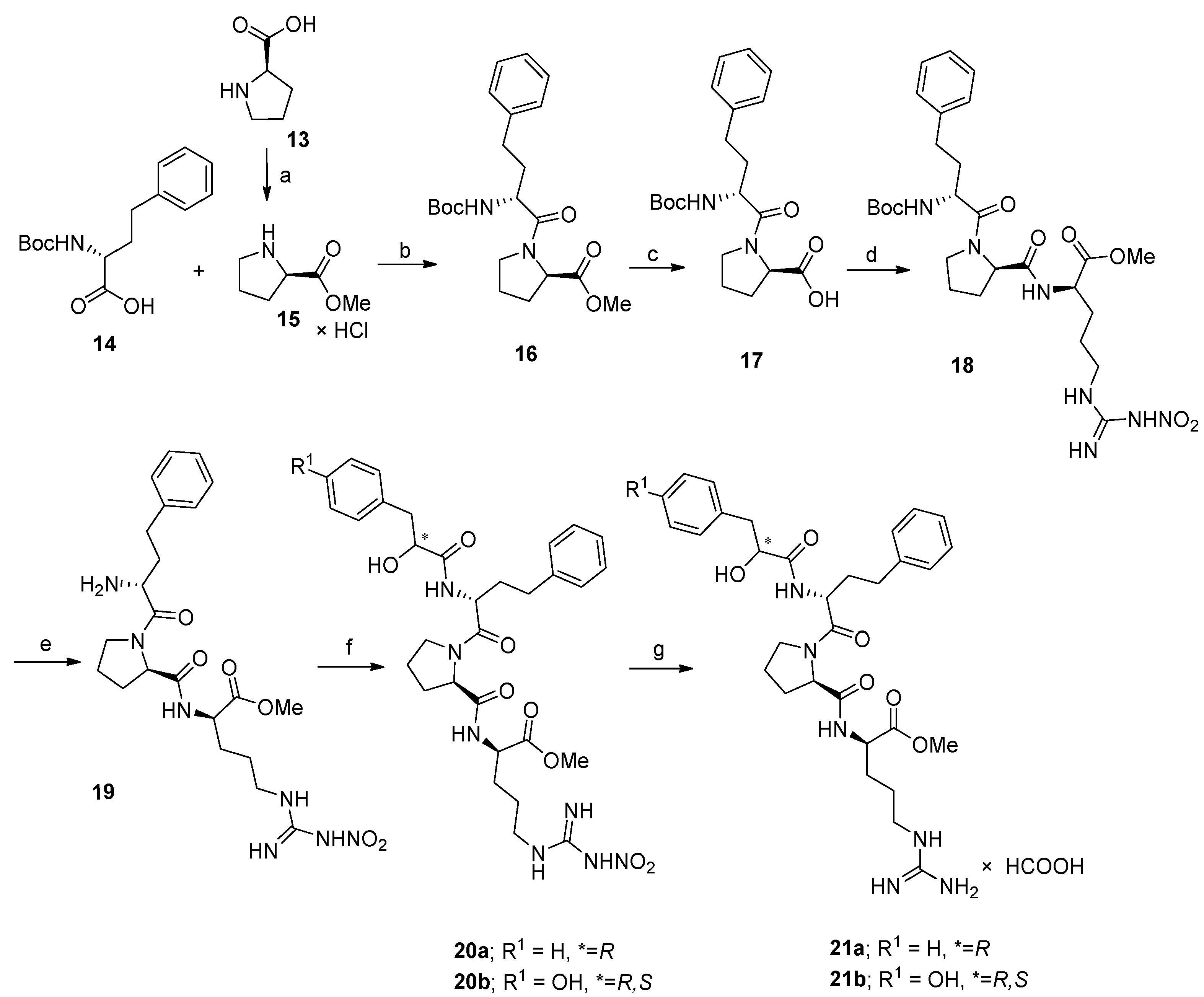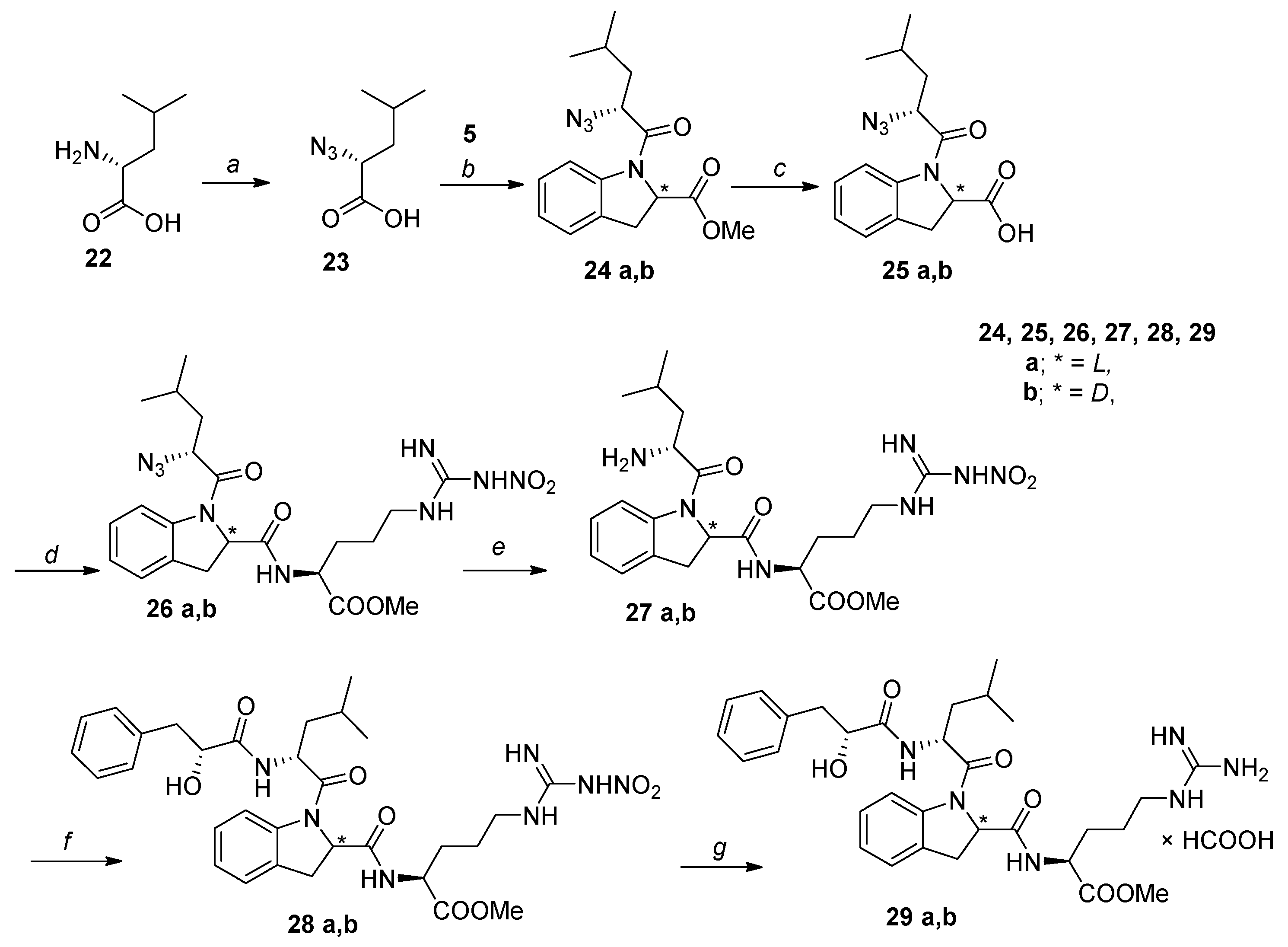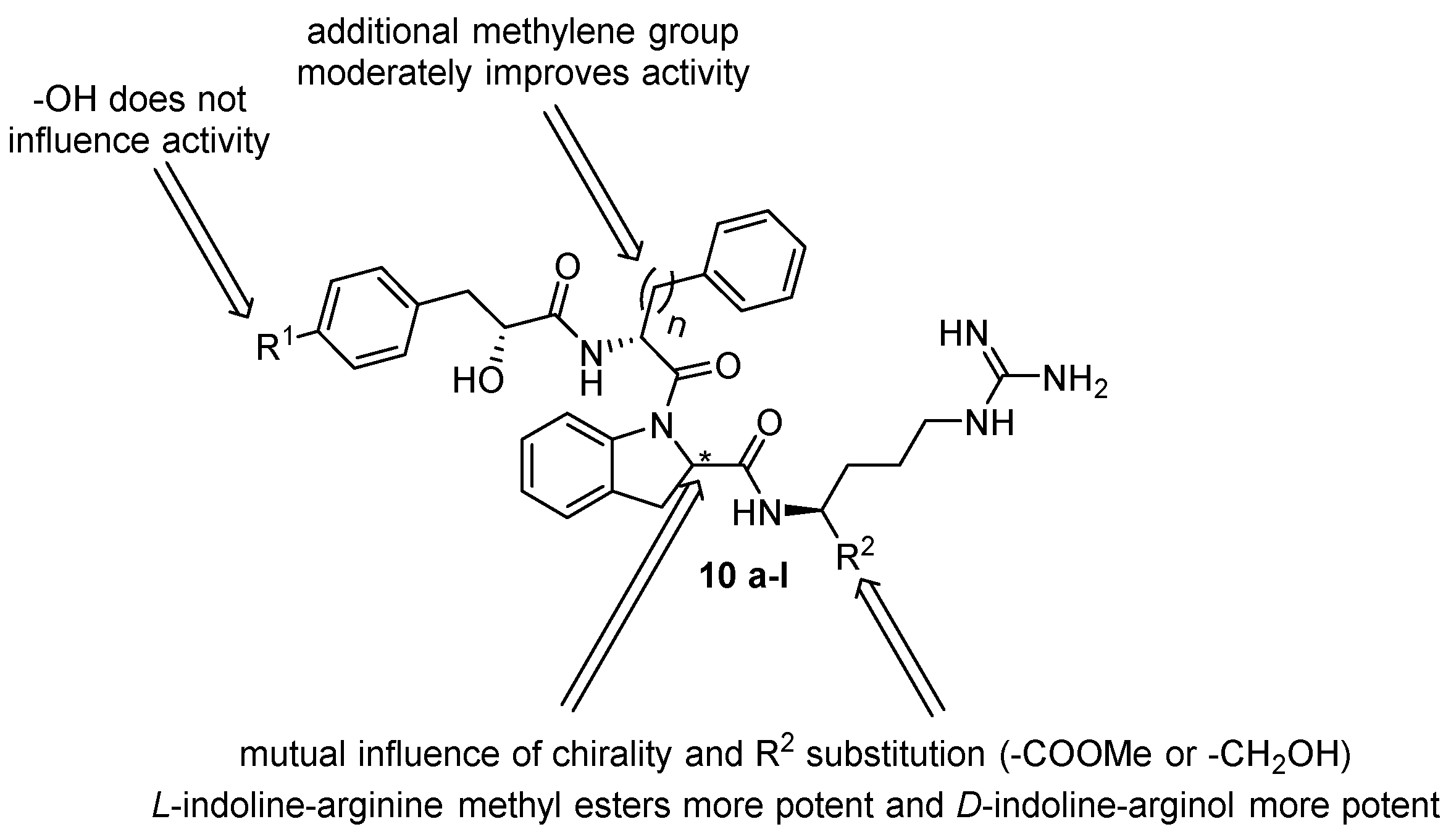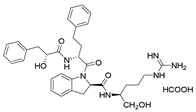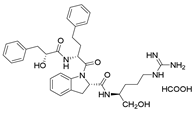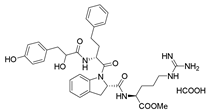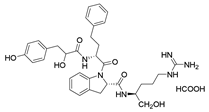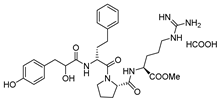6.10. General Procedure of Nitro Group Cleavage on Protected l-Arginine or l-Argininol Derivatives
To the solution of the nitro group-protected compound (0.5 mmol) in 25 mL anhydrous ethanol, palladium hydroxide on activated charcoal (30 wt %) and formic acid (189 μL, 5 mmol) were added under an argon atmosphere. The prepared mixture was flushed with H2 for 30 min, sealed and stirred for 12 h under H2 atmosphere at 35 °C. After the completion of the reaction, the Pd(OH)2/C was filtered and ethanol was evaporated under reduced pressure. The resulting residue was purified by flash column chromatography (SiO2) eluting with ethyl acetate and methanol containing 2% of formic acid to obtain the desired deprotected compound.
(R)-2-Azido-3-phenylpropanoic acid (2a). Synthesized from 1a (10 mmol) using the general procedure described in 6.4. Brown oil, yield: 1.34 g (70%). 1H NMR (DMSO-d6, 400 MHz): δ 2.93 (dd, 1H, J = 14.1 Hz, J = 8.9 Hz, -CHCH2Ph), 3.12 (dd, 1H, J = 14.1 Hz, J = 5.0 Hz, -CHCH2Ph), 4.40 (dd, 1H, J = 8.9 Hz, J = 5.0 Hz, -CHCH2Ph), 7.25–7.34 (m, 5H, -CHCH2Ph), 13.45 (bs, 1H, -COOH) ppm. 13C NMR (DMSO-d6, 100 MHz): δ 171.24, 136.68, 129.18, 128.87, 128.32, 126.74, 125.29, 62.22, 36.63 ppm. IR(ATR) ν: 3031, 2106, 1714, 1497, 1455, 1418, 1260, 1221, 1081, 749, 697 cm−1.
(R)-2-Azido-4-phenylbutanoic acid (2b). Synthesized from 1b (10 mmol) using the general procedure described in 6.4. Brown oil, yield: 1.48 g (72%). 1H NMR (DMSO-d6, 400 MHz): δ 1.86–1.95 (m, 1H, -CHCH2CH2Ph), 2.00–2.09 (m, 1H, -CHCH2CH2Ph), 2.65–2.69 (m, 2H, -CHCH2CH2Ph), 4.08 (dd, 1H, J = 8.8 Hz, J = 4.6 Hz, -CHCH2CH2Ph), 7.19–7.23 (m, 3H, -CHCH2CH2Ph), 7.28–7.33 (m, 2H, -CHCH2CH2Ph), 13.40 (bs, 1H, -COOH) ppm. 13C NMR (DMSO-d6, 100 MHz): δ 172.19, 141.03, 128.92, 128.79, 126.57, 61.26, 33.03, 31.77 ppm. IR(ATR) ν: 3028, 2929, 2104, 1713, 1497, 1454, 1419, 1227, 1030, 910, 748, 698 cm−1.
Methyl indoline-2-carboxylate hydrochloride (5). To the cooled (0 °C) solution of 1H-indoline-2-carboxylic acid (1.63 g, 10 mmol) in 30 mL of methanol, SOCl2 (2.4 mL, 33.3 mmmol) dropwise in 10 mL of methanol was added. The resulting mixture was stirred at 0 °C for 1 h and then for 12 h under reflux. After completion of the reaction (TLC), the solvent was removed under reduced pressure and the crude product was washed with ether (3 × 40 mL) and hexane (3 × 40 mL) to obtain a pure compound 5 (2.01 g, 94%) as a brown solid. 1H NMR (DMSO-d6, 400 MHz): δ 3.13 (dd, 1H, J = 16.1 Hz, J = 6.3 Hz, -NHCHCH2-), 3.34 (dd, 1H, J = 16.1 Hz, J = 10.3 Hz, -NHCHCH2-), 3.69 (s, 3H, -COOMe), 4.51 (dd, 1H, J = 10.3 Hz, J = 6.3 Hz, -NHCHCH2-), 6.16 (bs, 2H, -NHCHCH2-), 6.70–6.73 (m, 2H, indoline Ar-H), 7.02 (dt, 1H, J = 8.0 Hz, J = 7.8 Hz, J = 1.1 Hz, indoline Ar-H), 7.09 (dd, 1H, J = 7.7 Hz, J = 1.0 Hz, indoline Ar-H) ppm. 13C NMR (DMSO-d6, 100 MHz): δ 171.88, 130.35, 128.23, 125.40, 123.64, 114.35, 59.44, 53.00, 49.04, 33.26 ppm. IR(ATR) ν: 3319, 2898, 2664, 2547, 2492, 1735, 1623, 1486, 1464, 1440, 1408, 1339, 1301, 1264, 1110, 1025, 1043, 916, 769, 680 cm−1.
Methyl (R)-1-((R)-2-azido-3-phenylpropanoyl)indoline-2-carboxylate (6a). Synthesized from 3a (1.26 g, 6 mmol) and 5 (1.07 g, 5 mmol) using the general procedure described in 6.6. Colourless oil, yield: 0.7 g (40%). [α] −1.18 (c 0.206, MeOH), 1H NMR (DMSO-d6, 400 MHz): δ 3.06–3.11 (m, 1H, -CHCH2Ph), 3.20–3.26 (m, 3H, -NHCHCH2- + -CHCH2Ph), 3.67 (s, 3H, -COOMe), 4.31–4.35 (m, 1H, -CHCH2Ph), 5.06–5.09 (m, 1H, -NHCHCH2-), 7.06–7.10 (m, 1H, indoline Ar-H), 7.22–7.35 (m, 7H, indoline Ar-H + -CHCH2Ph), 8.12 (d, 1H, J = 7.7 Hz, indoline Ar-H) ppm. 13C NMR (DMSO-d6, 100 MHz): δ 173.24, 169.66, 143.19, 138.13, 131.29, 130.42, 130.28, 129.71, 128.67, 128.08, 126.15, 125.75, 118.66, 63.19, 61.93, 53.66, 37.41, 33.97 ppm. HRMS for C19H19N4O3: calculated 351.1457; found 351.1459. IR(ATR) ν: 3330, 3029, 2953, 2104, 1736, 1662, 1599, 1481, 1464, 1406, 1308, 1230, 1205, 1667, 1080, 1022, 1006, 931, 833, 749, 698, 666 cm−1.
(R)-1-((R)-2-Azido-3-phenylpropanoyl)indoline-2-carboxylic acid (7a). Synthesized from 6a (665 mg, 1.9 mmol) using the general procedure described in 6.7. White solid, yield: 606 mg (95%). 1H NMR (DMSO-d6, 400 MHz): δ 3.10 (dd, 1H, J = 14.3, J = 10.2 Hz, -CHCH2Ph), 3.20 (dd, 1H, J = 14.4 Hz, J = 3.4 Hz, -CHCH2Ph), 3.29–3.41 (m, 1H, -NHCHCH2), 3.63 (dd, 1H, J = 16.7 Hz, J = 11.1 Hz, -NHCHCH2-), 4.22 (dd, 1H, J = 10.5 Hz, J = 3.4 Hz, -CHCH2Ph), 5.50 (dd, 1H, J = 10.5 Hz, J = 1.9 Hz, -NHCHCH2-), 7.11 (t, 1H, J = 7.3 Hz, indoline Ar-H), 7.23–7.38 (m, 7H, indoline Ar-H + -CHCH2Ph), 8.13 (d, 1H, J = 8.0 Hz, indoline Ar-H) ppm. HRMS for C18H15N4O3: calculated 335.1144; found 335.1142. IR(ATR) ν: 3029, 2926, 2104, 1736, 1709, 1661, 1627, 1599, 1480, 1463, 1409, 1341, 1260, 1188, 1168, 1078, 883, 747, 701, 639 cm−1.
Methyl N2-((R)-1-((R)-2-azido-3-phenylpropanoyl)indoline-2-carbonyl)-Nω-nitro-l-argininate (8a). Synthesized from 7a (269 mg, 0.8 mmol) using the general coupling procedure type A. White solid, yield: 361 mg (82%). 1H NMR (DMSO-d6, 400 MHz): δ 1.56–1.84 (m, 4H, -CHCH2CH2CH2NH-), 3.05–3.07 (m, 2H, -CHCH2Ph), 3.13–3.17 (m, 3H, -CHCH2CH2CH2NH- + -NHCHCH2-), 3.61 (s, 3H, -COOMe), 3.72 (dd, 1H, J = 16.8 Hz, J = 11.0 Hz, -NHCHCH2-), 3.88 (dd, 1H, J = 8.8 Hz, J = 5.4 Hz, -CHCH2CH2CH2NH-), 4.21–4.26 (m, 1H, -CHCH2Ph), 5.34 (dd, 1H, J = 11.0 Hz, J = 2.7 Hz, -NHCHCH2-), 7.09 (t, 1H, J = 7.1 Hz, indoline Ar-H), 7.20–7.37 (m, 7H, indoline Ar-H + -CHCH2Ph), 8.14 (d, 1H, J = 7.9 Hz, indoline Ar-H), 8.57 (bs, 1H, guanidine-NH), 8.88 (d, 1H, J = 7.2 Hz, -CONH-) ppm. 13C NMR (MeOH-d4, 100 MHz): δ 172.39, 172.04, 168.20, 159.57, 142.48, 136.82, 129.82, 128.81, 128.74, 128.35, 128.18, 127.20, 126.74, 124.59, 124.27, 117.14, 62.00, 60.85, 52.54, 51.52, 40.22, 35.82, 34.03 ppm. HRMS for C25H28N9O6: calculated 550.2163; found 550.2160. IR(ATR) ν: 3286, 2928, 2104, 1739, 1626, 1597, 1535, 1482, 1408, 1256, 1211, 1151, 1019, 752, 669, 659 cm−1.
Methyl N2-((R)-1-(((R)-2-hydroxy-3-phenylpropanoyl)-d-phenylalanyl)indoline-2-carbonyl)-Nω-nitro-l-argininate (10a). Synthesized from 9a (120 mg, 0.23 mmol) using the general coupling procedure type C. White solid, yield: 95 mg (62%). 1H NMR (DMSO-d6, 400 MHz): δ 1.58–1.83 (m, 4H, -CHCH2CH2CH2NH-), 2.77 (dd, 1H, J = 13.4, J = 3.6 Hz, -CH(OH)CH2Ph), 2.90 (d, 1H, J = 13.4 Hz, -CH(OH)CH2Ph), 3.00 (dd, 1H, J = 13.4 Hz, J = 11.1 Hz, -CHCH2Ph), 3.18–3.21 (m, 3H, -CHCH2CH2CH2NH- + CHCH2Ph), 3.62–3.69 (m, 4H, -COOMe + -NHCHCH2-), 4.00–4.06 (m, 1H, -NHCHCH2-), 4.25 (dd, 1H, J = 12.4 Hz, J = 7.2 Hz, -CHCH2CH2CH2NH-), 4.44 (t, 1H, J = 7.4 Hz, -CHCH2Ph), 5.45 (d, 1H, J = 6.1 Hz, -NHCHCH2-), 5.64 (dd, 1H, J = 11.1 Hz, J = 2.9 Hz, -CH(OH)CH2Ph), 7.06–7.29 (m, 13H, indoline Ar-H + -CHCH2Ph + -CH(OH)CH2Ph), 8.14 (d, 1H, J = 8.0 Hz, indoline Ar-H), 8.21 (d, 1H, J = 7.6 Hz, -CONH-), 8.58 (bs, 1H, guanidine-NH), 8.97 (d, 1H, J = 6.7 Hz, -CONH-) ppm. 13C NMR (MeOH-d4, 100 MHz): δ 173.51, 172.20, 171.83, 170,45, 142.94, 138.07, 137.75, 130.00, 129.24, 128.96, 128.13, 127.79, 127.15, 126.34, 125.92, 124.63, 123.82, 116.47, 71.91, 60.24, 55.99, 54.90, 52.61, 52.34, 51.99, 40.33, 36.18, 33.91, 27.69, 18.54 ppm. HRMS for C34H38N7O8: calculated 672.2782; found 672.2793. IR(ATR): 3296, 3028, 2494, 1736, 1631, 1625, 1529, 1483, 1404, 1263, 1150, 1088, 1026, 736, 698, 632 cm−1.
Methyl ((R)-1-(((R)-2-hydroxy-3-phenylpropanoyl)-d-phenylalanyl)indoline-2-carbonyl)-l-argininate (11a). Synthesized from 10a (135 mg, 0.2 mmol) using the general procedure of nitro group cleavage described in 6.10. White solid, yield: 109 mg (81%). [α] −0.45 (c 0.130, MeOH), 1H NMR (DMSO-d6, 600 MHz): δ 1.57–1.61 (m, 2H, -CHCH2CH2CH2NH-), 1.70–1.73 (m, 1H, -CHCH2CH2CH2NH-), 1.79–1.82 (m, 1H, -CHCH2CH2CH2NH-), 2.52 (dd, 1H, J = 8.4 Hz, J = 5.3 Hz, -CH(OH)CH2Ph), 2.77 (dd, 1H, J = 13.8 Hz, J = 3.9 Hz,-CH(OH)CH2Ph), 2.91 (dd, 1H, J = 13.7 Hz, J = 1.9 Hz, -CHCH2Ph), 2.99 (dd, 1H, J = 14.0 Hz, J = 10.8 Hz, -CHCH2Ph), 3.04–3.11 (m, 2H, -CHCH2CH2CH2NH-), 3.22 (dd, 1H, J = 16.9 Hz, J = 2.1 Hz, -NHCHCH2-), 3.60 (s, 3H, -COOMe), 3.65 (dd, 1H, J = 17.0 Hz, J = 11.2 Hz, -NHCHCH2-), 4.01 (dd, 1H, J = 8.4 Hz, J = 4.0 Hz, -CHCH2CH2CH2NH-), 4.18–4.21 (m, 1H, -CHCH2Ph), 4.42–4.46 (m, 1H, -NHCHCH2-), 5.65 (dd, 1H, J = 11.4 Hz, J = 3.0 Hz, -CH(OH)CH2Ph), 7.03–7.29 (m, 13H, -CH(OH)CH2Ph + -CHCH2Ph + indoline Ar-H), 8.13 (d, 1H, J = 8.1 Hz, indoline Ar-H), 8.20 (d, 1H, J = 8.0 Hz, -CONH-), 8.45 (s, 1H, HCOO−), 9.16 (t, 1H, J = 4.4 Hz, guanidine-NH), 9.31 (d, 1H, J = 6.7 Hz, -CONH-), ppm. 13C NMR (DMSO-d6, 150 MHz): δ 173.45, 172.09, 171.76, 170.40, 166.34, 157.35, 142.88, 138.07, 137.69, 129.93, 129.17, 128.85, 128.05, 127.70, 126.29, 125.81, 123.70, 116.38, 71.81, 60.17, 52.62, 52.29, 51.85, 40.24, 40.07, 36.10, 33.82, 27.50, 25.03 ppm. HRMS for C34H41N6O6: calculated 629.3088; found 629.3083. IR(ATR) ν: 3323, 3212, 2960, 1738, 1640, 1531, 1483, 1454, 1419, 1201, 1134, 1002, 837, 800, 752, 699, 628 cm−1. HPLC: retention time 11.970 min, purity 98.6% (254 nm).
((R)-1-(((R)-2-hydroxy-3-phenylpropanoyl)-d-phenylalanyl)indoline-2-carbonyl)-l-arginine (12g). Synthesized from 11g (30 mg, 0.045 mmol) using the general procedure of ester hydrolysis, type B. White solid, yield: 21 mg (71%). 1H NMR (DMSO-d6, 400 MHz): δ 1.38–1.42 (m, 2H, -CHCH2CH2CH2NH-), 1.56–1.67 (m, 2H, -CHCH2CH2CH2NH-), 2.63–2.69 (m, 1H, -CH(OH)CH2Ph), 2.90–2.94 (m, 3H, -CH(OH)CH2Ph + -CHCH2CH2CH2NH-), 2.99–3.03 (m, 3H, -CHCH2Ph + -NHCHCH2-), 3.42 (dd, 1H, J = 16.5 Hz, J = 10.5 Hz, -NHCHCH2-), 3.92 (dd, 1H, J = 12.0 Hz, J = 5.9 Hz, -CHCH2CH2CH2NH-), 4.09 (dd, 1H, J = 8.1 Hz, J = 3.4 Hz, -CHCH2Ph), 4.68 (dd, 1H, J = 14.1 Hz, J = 6.3 Hz, -NHCHCH2-), 5.02 (dd, 1H, J = 10.9 Hz, J = 2.2 Hz, -CH(OH)CH2Ph), 7.00–7.05 (m, 3H, indoline Ar-H + -CHCH2Ph), 7.18–7.28 (m, 10H, indoline Ar-H + -CH(OH)CH2Ph + -CHCH2Ph), 7.69 (d, 1H, J = 8.0 Hz, -CONH-), 7.98 (d, 1H, J = 6.6 Hz, -CONH-), 8.03 (d, 1H, J = 8.0 Hz, indoline Ar-H), 8.36 (s, 1H, HCOO−), 8.92–8.96 (m, 1H, guanidine-NH) ppm. 13C NMR (DMSO-d6, 100 MHz): δ 174.42, 172.42, 168.82, 165.74, 157.93, 143.17, 138.90, 136.42, 130.58, 130.13, 130.02, 128.51, 128.38, 127.26, 127.04, 126.51, 125.09, 124.36, 116.86, 72.28, 60.90, 54.05, 52.23, 40.87, 40.76, 38.91, 35.00, 29.62, 25.55 ppm. HRMS for C33H39N6O6: calculated 615.2931; found 615.2943. IR(ATR) ν: 3320, 2964, 2777, 1740, 1617, 1481, 1451, 1412, 1352, 1199, 1132, 1004, 837, 800, 773, 765, 699, 632 cm−1. HPLC: retention time 11.951 min, purity 98.6% (254 nm).
Methyl d-prolinate hydrochloride (12a). d-proline (10.0 g; 86.8 mmol) was dissolved in 100 mL of absolute methanol and 12.3 mL of thionyl chloride (20.6 g; 173 mmol) was added dropwise at 0 °C. The reaction mixture was then stirred under the reflux for 3 h. The solvent was evaporated under the reduced pressure and oily product was washed with hexane to obtain 12.9 g of pure 15 (97%). 1H NMR (DMSO-d6, 400 MHz): δ 1.87–2.02 (m, 3H, Pro-H3, Pro-H3, Pro-H4), 2.22–2.31 (m, 1H, Pro-H4), 3.16–3.75 (m, 2H, Pro-H5), 3.77 (s, 3H, COOCH3), 4.38 (dd, J = 7.4 Hz, J = 8.5 Hz, 1H, Pro-H2) ppm; IR(ATR) ν: 765, 918, 1038, 1092, 1231, 1356, 1439, 1566, 1741, 2713, 2904 cm−1.
Methyl ((R)-2-((tert-butoxycarbonyl)amino)-4-phenylbutanoyl)-d-prolinate (16). Synthesized from aminoacid 14 (250 mg; 0.895 mmol) and 7a (148 mg; 0.895 mmol) using the general coupling procedure type A. Oil, yield: 285 mg (81%). 1H NMR (DMSO-d6, 400 MHz): δ (ppm) 1.41 (s, 9H, (CH3)3C), 1.72–1.92 (m, 5H, Phe-β-CH2, Pro-H4, Pro-H3), 2.07–2.16 (m, 1H, Pro-H3), 2.55–2.57 (m, 2H, Ph-γ-CH2), 3.42–3.51 (m, 2H, Pro-H5), 3.59 (s, COOMe), 4.22 (4.89), (dd, J = 3.9 Hz, J = 8.8 Hz, 2H, Ph-α-CH; Pro-H2), 7.20–7.29 (m, 5H, -CH2CH2Ph), MS (ESI) m/z 377.3 (MH+, 100); IR(ATR) ν: 700, 750, 871, 1023, 1047, 1092, 1164, 1246, 1365, 1391, 1432, 1496, 1641, 1703, 1743, 2975, 3294 cm−1. HPLC (λ = 254 nm) Rt 13.19 min, 97.4%.
((R)-2-((tert-butoxycarbonyl)amino)-4-phenylbutanoyl)-d-proline (17). Synthesized from 16 (665 mg, 1.9 mmol) using the general procedure described in 6.7. White solid, yield: 229 mg (81%). 1H NMR (DMSO-d6, 400 MHz): δ 1.39 (s, 9H, (CH3)3C), 1.73–1.91 (m, 5H, Phe-β-CH2, Pro-H4, Pro-H3), 2.05–2.18 (m, 1H, Pro-H3), 2.54–2.68 (m, 2H, Ph-γ-CH2), 3.50–3.51 (m, 2H, Pro-H5), 4.15 (dd, J = 3.4 Hz, J = 8.8 Hz, 2H, Ph-α-CH, Pro-H2), 4.23 (4.77) (dd, J = 8.6 Hz, J = 14.0 Hz, 1H, Ph-α-CH), 7.14–7.33 (m, 5H, -CH2CH2Ph) ppm; IR(ATR) ν: 669, 700, 739, 759, 886, 1021, 1041, 1156, 1192, 1244, 1273, 1338, 1364, 1388, 1455, 1520, 1609, 1700, 1716, 2883, 2951, 2980, 3023, 3280 cm−1. HPLC (λ = 254 nm) Rt 13.19 min, 93.4%
Methyl N2-(((R)-2-((tert-butoxycarbonyl)amino)-4-phenylbutanoyl)-d-prolyl)-Nω-nitro-d-argininate (18). Synthesized from 17 (160 mg; 0.439 mmol) and H-Arg(NO2)-OMe·HCl (118 mg; 0.439 mmol) using the general coupling procedure type A. White solid, yield: 259 mg (95%). 1H NMR (DMSO-d6, 400 MHz): δ 1.39 (s, 9H, (CH3)3C), 1.54–1.66 (m, 4H, Arg-β-CH2, Arg-γ-CH2), 1.73–1.89 (m, 5H, Phe-β-CH2, Pro-H4, Pro-H3), 1.95–2.07 (m, 1H, Pro-H3), 2.56–2.69 (m, 2H, Ph-γ-CH2), 3.15 (dd, J = 6.1 Hz, J = 12.3 Hz, 2H, Arg-δ-CH2), 3.52 (dd, J = 6.8 Hz, J = 13,3 Hz, 2H, Pro-H5), 3.61 (s, 3H, COOCH3), 4.12 (dd, J = 7.3 Hz, J = 13.5 Hz, 1H, Arg-α-CH) 4.21 (dd, J = 7.3 Hz, J = 12.9 Hz, 1H, Ph-α-CH), 4.28–4.32 (4.81–4.84) (m, 1H, Pro-H2), 7.13–7.31 (m, 5H, -CH2CH2Ph), 8.13 (d, J = 7.5 Hz, 1H, BocNHCH-), 8.52 (d, J = 7.8 Hz, 1H, -ProCONHCH-) ppm. 13C NMR (DMSO-d6, 100 MHz) δ 22.38, 24.64, 28.36, 29.09, 31.18, 31.40, 31.74, 34.25, 34.82, 46.50, 46.72, 51.45, 52.29, 58.96, 59.18, 76.74, 77.06, 77.38, 79.65, 79.84, 125.95, 126.07, 128.44, 128.48, 141.22, 155.44, 170.76, 172.40 ppm. IR(ATR) ν: 3305, 2952, 1741, 1622, 1529, 1435, 1391, 1365, 1251, 1161, 1047, 1024, 700, 728 cm−1. MS (ESI) m/z 592.3 (MH+, 100) HPLC: Rt 12.88 min, 91.3%. M.p. 93–94 °C.
Methyl N2-(((R)-2-amino-4-phenylbutanoyl)-d-prolyl)-Nω-nitro-d-argininate (19). To a solution of 18 (220 mg; 0.372 mmol) in 20 mL of dry methanol a dropwise of dry 1 M HCl (1.49 mL; 2.97 mmol) was added. The resulting mixture was stirred for an additional 15 min under an argon atmosphere. After 2 h, 1 M HCl was added (0.929 mL; 1.86 mmol) and it was left over the night at a room temperature. The next day, an additional 1 M HCl (0.929 mL; 1.86 mmol) was added and the reaction mixture was heated up to 35 °C and left over the night. The solvent was evaporated under the reduced pressure and flushed with argon to obtain the solid product. The yield of the reaction was 0.189 g (96%). 1H NMR (DMSO-d6, 400 MHz): δ 1.35–1.40 (m, 2H, Arg-γ-CH2), 1.66–1.78 (m, 2H, Arg-β-CH2), 1.82–1.92 (m, 3H, Phe-β-CH2, Pro-H3), 1.99–2.08 (m, 3H, Pro-H3, Pro-H4), 2.68–2.72 (m, 2H, Ph-γ-CH2), 3.36 (dd, J = 7.9 Hz, J = 16.8 Hz, 2H, Arg-δ-CH2), 3.46–3.52 (m, 2H, Pro-H5), 3.62 (s, 3H, COOCH3), 4.15–4.21 (m, 2H, Pro-H2, Ph-α-CH), 4.32 (4.84) (d, J = 9.8 Hz, 1H, Pro-H2), 7.22–7.34 (m, 5H, -CH2CH2Ph), 8.39–8.45 (m, 1H,-ProCONHCH-) 8.48 (d, J = 7.5 Hz, 2H, -NH2) ppm, MS (ESI) m/z 464.2 (MH+, 100); IR(ATR) ν: 626, 700, 1145, 1280, 1451, 1495, 1536, 1635, 1731, 2953, 3241 cm−1. HPLC (λ = 254 nm) Rt 10.15 min, 93.3%
Methyl N2-(((R)-2-((R)-2-hydroxy-3-phenylpropanamido)-4-phenylbutanoyl)-d-prolyl)-Nω-nitro-d-argininate (20a). Synthesized from 19 (98 mg; 0.186 mmol) and 3-phenyl-d-lactic acid (31 mg; 0.186 mmol) using the general coupling procedure type A. White solid, yield: 75 mg (63%). 1H NMR (DMSO-d6, 400 MHz): δ 1.47–1.66 (m, 4H, Arg-γ-CH2, Arg-β-CH2), 1.70–1.92 (m, 4H, Phe-β-CH2, Pro-H4), 1.97–2.08 (m, 1H, Pro-H3), 2.74–2.83 (m, 2H, Ph-γ-CH2), 2.97–3.04 (m, 2H, Phe-lactic-γ-CH2), 3.15 (dd, J = 6.1 Hz, J = 12.2 Hz, 2H, Arg-δ-CH2), 3.49–3.57 (m, 2H, Pro-H5), 3.61 (s, 3H, COOCH3), 4.08–4.23 (m. 1H, Ph-α-CH), 4.56–4.61 (4.79–4.83) (m, 1H, Pro-H2), 5.83 (d, 1H, Ph-lactic-OH) 7.16–7.31 (m, 10H, -CH2CH2Ph, Ph-lactic), 7.74 (7.82) (d, J = 8.3 Hz, 1H, -ProCONHCH-), 8.23 (8.56) (d, J = 7.5 Hz, 1H, Phe-lactic-NH) ppm. MS (ESI) m/z 640.3 (MH+, 100), IR(ATR) ν: 640, 698, 742, 845, 913, 1028, 1086, 1150, 1252, 1342, 1433, 1496, 1528, 1619, 1741, 3290 cm−1. HPLC (λ = 254 nm) Rt 12.51 min, 98.15%
Methyl N2-(((2R)-2-((R,S)-2-hydroxy-3-(4-hydroxyphenyl)propanamido)-4-phenylbutanoyl)-d-prolyl)-Nω-nitro-d-argininate (20b). Synthesized from 19 (91 mg; 0.172 mmol) and 2-hydroxy-3-(4-hydroxyphenyl)propanoic acid (35 mg; 0.172 mmol) using the general coupling procedure type C. White solid, yield: 20 mg (31%). 1H NMR (DMSO-d6, 400 MHz): δ 1.50–1.65 (m, 4H, Arg-γ-CH2, Arg-β-CH2), 1.70–1.92 (m, 4H, Phe-β-CH2, Pro-H4), 1.97–2.08 (m, 1H, Pro-H3), 2.54–2.57 (m, 2H, Ph-γ-CH2), 2.80–2.94 (m, 2H, Phe-lactic-γ-CH2), 3.11–3.21 (m, 2H,-Arg-δ-CH2), 3.48–3.57 (m, 2H, Pro-H5), 3.6 (s, 3H, -COOCH3), 4.05–4.15 (4.17–4.25) (m. 2H, Ph-α-CH, HO-Phelactic-α-CH), 4.27–4.34 (m, 1H, Ph-α-CH), 4.54–4.59 (4.79–4.82) (m, 1H, Pro-H2), 5.73 (5.53; 5.43) (d, J = 5.8 Hz, HO-Phe-lactic-OH), 6.98–7.31 (m, 9H, -CH2CH2Ph, OH-Phelactic), 7.71 (7.81; 7.97), (d, J = 8.3 Hz, 1H, OH-Ph-lactic-NH), 8.22 (8.51–8.57) (dd, J = 3.4 Hz, J = 7.6 Hz, 2H, -ProCONHCH-, OH-Ph-lactic-NH), 9.13 (t, J = 2.4 Hz, 1H, HO-Phelactic) ppm. MS (ESI) m/z 656.3 (MH+, 100). IR(ATR) ν: 620, 639, 699, 745, 1106, 1256, 1440, 1515, 1624, 1739, 2952, 3286 cm−1. HPLC (λ = 254 nm) Rt 11.31 min, 95.0%. M.p. 97–99 °C.
Methyl ((R)-2-((R)-2-hydroxy-3-phenylpropanamido)-4-phenylbutanoyl)-d-prolyl-d-argininate (21a). Synthesized from 20a (55 mg; 0.085 mmol) using the general procedure of nitro group cleavage described in 6.10. White solid, yield: 19 mg (37%). 1H NMR (DMSO-d6, 400 MHz): δ 1.51–1.89 (m, 8H, Arg-γ-CH2, Arg-β-CH2, 4H, Phe-β-CH2, Pro-H4), 1.97–2.11 (m, 2H, Pro-H3), 2.74–2.83 (m, 2H, Ph-γ-CH2), 3.02 (dd, J = 3.6 Hz, J = 13.7 Hz, 4H, Arg-δ-CH2, Pro-H5), 3.60 (s, 3H, COOCH3), 4.11–4.19 (4.55–4.61) (m, 2H, Ph-α-CH, Arg-α-CH), 4.31 (4.83) (dd, J = 4.4 Hz, J = 6.6 Hz, (m, 1H, Pro-H2), 6.01–6.26 (m, 2H, Arg-NH2), 7.13–7.31 (m, 10H, -CH2CH2Ph; Ph-lactic), 7.82 (8.90) (dd, J = 9.5 Hz, J = 20.7 Hz, 1H, -ProCONHCH-), 9.16 (9.30) (s, 1H, Phe-lactic-NH) ppm, MS (ESI) 595.3 (MH+, 100), IR(ATR) ν: 699, 772, 1088, 1200, 1353, 1390, 1452, 1589, 1739, 2828, 2925, 3962, 3280 cm−1. HPLC (λ = 254 nm) Rt 15.98 min, 96.9%. M.p. 69–70 °C.
Methyl ((R)-2-((R,S)-2-hydroxy-3-(4-hydroxyphenyl)propanamido)-4-phenylbutanoyl)-d-prolyl-d-argininate (21b). Synthesized from 20b (62.0 mg; 0.094 mmol) using the general procedure of nitro group cleavage described in 6.10. White solid, yield: 20 mg (31%). 1H NMR (DMSO-d6, 400 MHz): δ 1.52–1.90 (m, 8H, Arg-γ-CH2, Arg-β-CH2, 4H, Phe-β-CH2, Pro-H4), 1.97–2.10 (m, 2H, Pro-H3), 2.72–2.81 (m, 2H, Ph-γ-CH2), 3.01 (dd, J = 3.6 Hz, J = 13.6 Hz, 4H, Arg-δ-CH2, Pro-H5), 3.59 (s, 3H, COOCH3), 4.11–4.19 (4.55–4.61) (m, 2H, Ph-α-CH, Arg-α-CH), 4.31 (4.83) (dd, J = 4.4 Hz, J = 6.6 Hz, (m, 1H, Pro-H2), 6.01–6.26 (m, 2H, Arg-NH2), 7.13–7.31 (m, 9H, -CH2CH2Ph; -CH(OH)CH2Ph(OH)), 7.81 (8.99) (dd, J = 9.4 Hz, J = 20.6 Hz, 1H, -ProCONHCH-), 8.91 (8.93) (s, 1H, -CH(OH)CH2Ph(OH)) 9.16 (9.30) (s, 1H, Phe-lactic-NH) ppm, IR(ATR) ν: 699, 814, 1018, 1104, 1200, 1352, 1444, 1513, 1608, 1648, 1730, 3149 cm−1. MS (ESI) m/z 611.3 (MH+, 100). HPLC ret. time 10.63 min and 10.67, 85.09%. M.p. 105–106 °C.
(R)-2-azido-4-methylpentanoic acid (23). Synthesized from d-leucine (1.20 g; 9.15 mmol) using the general procedure described in 6.4. Brown oil, yield: 1.03 g (71%) and was used without additional purification and characterisation.
Methyl (R)-1-((R)-2-azido-4-methylpentanoyl)indoline-2-carboxylate (24a). Synthesized from 23 (1.26 g, 6 mmol) and 5 (1.07 g, 5 mmol) using the general procedure described in 6.6. Colourless oil, yield: 0.71 g (40%). 1H NMR (DMSO-d6, 400 MHz): δ 0.93 (dd, J = 6.5 Hz, J = 22.3 Hz, 6H, leucine-δ-CH3, leucine-δ-CH3), 1.53–1.59 (m, 2H, leucine-γ-CH2), 1.68–1.84 (m, 2H, leucine-β-CH2), 3.27–3.34 (m, 1H, indoline-H3), 3.62–2.70 (m, 1H, indoline-H3), 4.01(dd, J = 3.6 Hz, J = 9.6 Hz, 1H, indoline-H2), 5.6 (d, J = 10.5 Hz, 1H, leucine-α-CH), 7.10 (dd, J = 4.2 Hz, J = 11.5 Hz, 1H, indoline Ar-H), 7.22–7.30 (m, 2H, indoline Ar-H;), 8.08 (d, J = 8.0 Hz, 1H, indoline Ar-H) ppm. HPLC (λ = 254 nm) Rt 16.15 min, 99.7%. M.p. 67–68 °C.
Methyl (S)-1-((S)-2-azido-4-methylpentanoyl)indoline-2-carboxylate (24b). Synthesized from 23 (1.26 g, 6 mmol) and 5 (1.07 g, 5 mmol) using the general procedure described in 6.6. Colourless oil, yield: 0.69 g (43%). 1H NMR (DMSO-d6, 400 MHz): δ 0.93 (dd, J = 6.5 Hz, J = 22.3 Hz, 6H, leucine-δ-CH3, leucine-δ-CH3), 1.53–1.59 (m, 2H, leucine-γ-CH2), 1.68–1.84 (m, 2H, leucine-β-CH2), 3.27–3.34 (m, 1H, indoline-H3), 3.62–2.70 (m, 1H, indoline-H3), 4.01(dd, J = 3.6 Hz, J = 9.6 Hz, 1H, indoline-H2), 5.6 (d, J = 10.5 Hz, 1H, leucine-α-CH), 7.10 (dd, J = 4.2 Hz, J = 11.5 Hz, 1H, indoline Ar-H), 7.22–7.30 (m, 2H, indoline Ar-H), 8.08 (d, J = 8.0 Hz, 1H, indoline Ar-H) ppm. HPLC (λ = 254 nm) Rt 16.15 min, 99.7%. M.p. 67–68 °C.
(R)-1-((R)-2-azido-4-methylpentanoyl)indoline-2-carboxylic acid (25a). Synthesized from 24a (254 mg; 0.803 mmol) using the general procedure of ester hydrolysis (6.6.) White solid, yield: 213 mg (87%). 1H NMR (DMSO-d6, 400 MHz): δ 0.96 (dd, J = 6.1 Hz, J = 12.8 Hz, 6H, leucine-δ-CH3, leucine-δ-CH3), 1.68–1.81 (m, 4H, leucine-γ-CH2, leucine-β-CH2), 3.2–3.4 (d, J = 16.8 Hz,1H indoline-H3), 3.64 (dd, J = 10.7 Hz, J = 16.6 Hz, 1H, indoline-H3), 3.81–3.85 (dd, J = 3.8 Hz, J = 9.7 Hz, 1H, indoline-H2), 5.06 (dd, J = 2.3 Hz, J = 10.8 Hz, 1H, leucine-α-CH), 7.08 (dt, J = 1.0 Hz, J = 7.4 Hz, J = 7.5 Hz, 1H, indoline Ar-H), 7.21–7.29 (m, 2H, indoline Ar-H), 8.12 (d, i = 8.00 Hz, 1H, indoline Ar-H) ppm. IR(ATR) ν: 752, 1120, 1166, 1208, 1233, 1304, 1405, 1463, 1481, 1596, 1655, 1724, 2109, 2871, 2958 cm−1. HPLC (λ = 254 nm) Rt 17.25 min., 97.4%
(S)-1-((R)-2-azido-4-methylpentanoyl)indoline-2-carboxylic acid (25b). Synthesized from 24b (201 mg; 0.635 mmol) using the general procedure of ester hydrolysis (6.6.). White solid, yield: 146 mg (87%). 1H NMR (DMSO-d6, 400 MHz): δ 0.93 (dd, J = 6.3 Hz, J = 15.6 Hz, 6H, leucine-δ-CH3, leucine-δ-CH3), 1.61–1.84 (m, 4H, leucine-γ-CH2, leucine-β-CH2), 3.3 (d, J = 16.8 Hz,1H indoline-H3), 3.61 (dd, J = 10.7 Hz, J = 16.6 Hz, 1H, indoline-H3), 3.97 (dd, J = 3.8 Hz, J = 9.7 Hz, 1H, indoline-H2), 5.40 (dd, J = 5.0 Hz, J = 6.2 Hz, 1H, leucine-α-CH), 7.09 (dt, J = 1.0 Hz, J = 7.5 Hz, 1H, indoline Ar-H), 7.21–7.29 (m, 2H, indoline Ar-H), 8.1 (d, J = 7.9 Hz, 1H, indoline Ar-H) ppm. IR(ATR) ν: 634, 684, 707, 757, 832, 870, 912, 1022, 1093, 1119, 1181, 1216, 1253, 1265, 1355, 1402, 1429, 1461, 1732, 2114, 2869, 2955, 3072 cm−1. HPLC (λ = 254 nm) Rt 14.23 min, 98.6%.
Methyl N2-((R)-1-((R)-2-azido-4-methylpentanoyl)indoline-2-carbonyl)-Nω-nitro-l-argininate (26a). Synthesized from 25b (213 mg; 0.705 mmol) using the general coupling procedure type A. White solid, yield: 255 mg (70%). 1H NMR (DMSO-d6, 400 MHz): δ 1.00 (dd, J = 6.5 Hz, J = 9.9 Hz, 6H, leucine-δ-CH3, leucine-δ-CH3), 1.53–1.82 (m, 8H, Arg-β-CH2, Arg-γ-CH2, leucine-γ-CH2, leucine-β-CH2), 3.18 (dd, J = 5.9 Hz, J = 13.2 Hz, 2H, Arg-δ-CH2), 3.63 (s, 3H, COOCH3), 3.66–3.76 (s, 2H, indoline-H3), 4.19–4.25 (m, 1H, indoline-H2), 4.95 (dd, J = 3.2 Hz, J = 11.1 Hz, 1H, leucine-α-CH), 7.05 (dt, J = 0.77 Hz, J = 7.42 Hz, 1H, indoline Ar-H), 7.22 (dd, J = 7.4 Hz, J = 8.2 Hz, 2H, indoline Ar-H), 8.13 (d, J = 8.2 Hz, 1H, indoline Ar-H), 8.89 (d, J = 6.8 Hz, 1H, indoline-CONHCH-) ppm. IR(ATR) ν: 754, 914, 1021, 1149, 1255, 1405, 1462, 1481, 1537, 1597, 1626, 1742, 2112, 2870, 2956, 3299 cm−1. HPLC (λ = 254 nm) Rt 13.30 min, 98.3%.
Methyl N2-((S)-1-((R)-2-azido-4-methylpentanoyl)indoline-2-carbonyl)-Nω-nitro-l-argininate (26b). Synthesized from 25b (146 mg; 0.483 mmol) using the general coupling procedure type A. White solid, yield: 152 mg (61%). 1H NMR (DMSO-d6, 400 MHz): δ 0.88 (dd, J = 6.5 Hz, J = 24.0 Hz, 6H, leucine-δ-CH3, leucine-δ-CH3), 1.50–1.80 (m, 8H, Arg-β-CH2, Arg-γ-CH2, leucine-γ-CH2, leucine-β-CH2), 3.13–3.21 (m, 2H, Arg-δ-CH2), 3.61 (s, 5H, COOCH3, indoline-H3), 4.04–4.08 (m, 1H, 1H, Arg-α-CH), 4.14–4.21 (m, 1H, indoline-H2), 5.25 (dd, J = 3.4 Hz, J = 11.5 Hz, 1H, leucine-α-CH), 7.07 (t, J = 7.93 Hz, 1H, indoline Ar-H), 7.20–7.29 (m, 2H, indoline Ar-H), 8.09 (d, J = 9.0 Hz, 1H, indoline Ar-H), 8.81 (d, J = 7.4 Hz, 1H, indoline-CONHCH-) ppm. IR(ATR) ν: 659, 755, 1003, 1100, 1150, 1209, 1254, 1408, 1462, 1481, 1536, 1597, 1656, 1742, 2104, 2870, 2955, 3295 cm−1. HPLC (λ = 254 nm) Rt 13.27 min, 98.1%.
Methyl N2-((R)-1-(d-leucyl)indoline-2-carbonyl)-Nω-nitro-l-argininate (27a). Synthesized from 26a (272 mg; 0,553 mmol) using the general procedure of azido group reduction (6.9.). Crude product (187 mg, 69%) was used further without purification.
Methyl N2-((S)-1-(d-leucyl)indoline-2-carbonyl)-Nω-nitro-l-argininate (27b). Synthesized from 26b (390 mg; 0.753 mmol) using the general procedure of azido group reduction (6.9.). Crude product (185 mg, 50%) was used further without purification.
Methyl N2-((R)-1-(((R)-2-hydroxy-3-phenylpropanoyl)-d-leucyl)indoline-2-carbonyl)-Nω-nitro-l-argininate (28a). Synthesized from 27a (187 mg; 0.380 mmol) and 3-phenyl-d-lactic acid (64.5 mg; 0.380 mmol) using the general coupling procedure type C. White solid, yield: 207 mg (83%). 1H NMR (DMSO-d6, 400 MHz): δ 0.82 (d, J = 6.3 Hz, 3H, leucine-δ-CH3), 0.97 (d, J = 6.1, 3H, leucine-δ-CH3),1.3–1.81 (m, 8H, Arg-β-CH2, Arg-γ-CH2, leucine-γ-CH2, leucine-β-CH2), 2.73–2.79 (m, 2H, Phe-lactic-γ-CH2), 3.05–3.20 (m, 2H, Arg-δ-CH2), 3.65 (s, 3H, COOCH3), 3.69–3.78 (m, 2H, indoline-H3), 4.20–4.29 (m, 1H, 1H, Arg-α-CH), 4.41 (t, J = 10.3 Hz, 1H, indoline-H2), 4.97 (dd, J = 10.8 Hz, 1H, leucine-α-CH), 5.93 (d, J = 5.7 Hz, 1H, Phe-lactic-β-CH2), 7.01–7.09 (m, 1H, indoline Ar-H), 7.17–7.34 (m, 7H, indoline Ar-H, Phe-lactic-), 7.6 (d, J = 8.8 Hz, 1H, Phe-lactic-NH-), 8.09 (d, J = 8.5 Hz, 1H, indoline Ar-H), 8.79 (d, J = 9.4 Hz, 1H, indoline-CONHCH-) ppm, MS (ESI) m/z 640.3 (MH+, 100), IR(ATR) ν: 615, 640, 700, 7541, 1017, 1085, 1155, 1259, 1407, 1463, 1481, 1525, 1597, 1628, 1739, 2358, 2870, 2924, 2954, 3104, 3327, 3389, 3435, 3598 cm−1. HPLC (λ = 254 nm) Rt 13.29 min, 94.3%. M.p. 106–107 °C
Methyl N2-((S)-1-(((R)-2-hydroxy-3-phenylpropanoyl)-d-leucyl)indoline-2-carbonyl)-Nω-nitro-l-argininate (28b). Synthesized from 27b (185 mg; 0.376 mmol) and 3-phenyl-d-lactic acid (64.5 mg; 0.380 mmol) using the general coupling procedure type C. White solid, yield: 99 mg (41%). 1H NMR (DMSO-d6, 400 MHz): δ 0.70 (d, J = 6.4 Hz, 3H, leucine-δ-CH3), 0.81 (d, J = 6.5, 3H, leucine-δ-CH3), 1.21–1.40 (m, 4H, Arg-β-CH2, Arg-γ-CH2), 1.57–1.81 (m, 4H, leucine-γ-CH2, leucine-β-CH2), 2.76 (dd, J = Hz, 6.7 Hz, J = 14.1 Hz, 2H, Phe-lactic-γ-CH2), 3.13–3.25 (m, 2H, Arg-δ-CH2), 3.39–3.48 (m, 1H, indoline-H3), 3.61 (s, 3H, COOCH3), 4.13–4.20 (m, 1H, Arg-α-CH), 4.27–4.33 (m, 1H, indoline-H2), 5.69 (dd, J = 5.5 Hz, J = 13.4 Hz, 2H, leucine-α-CH, Phe-lactic-β-CH2), 7.01–7.07 (t, J = 7.93 Hz, 1H, indoline Ar-H), 7.11–7.26 (m, 7H, indoline Ar-H, Phe-lactic-), 7.82 (d, J = 6.2 Hz, 1H, Phe-lactic-NH-), 8.10 (d, J = 8.4 Hz, 1H, indoline Ar-H), 8.90 (d, J = 8.9 Hz, 1H, indoline-CONHCH-) ppm. MS (ESI) m/z 640.3 (MH+, 100). IR(ATR) ν: 616, 699, 749, 1003, 1086, 1152, 1209, 1256, 1342, 1418, 1481, 1534, 1595, 1630, 1740, 2954, 3287, 3675, 3853 cm−1. HPLC (λ = 254 nm) Rt 12.77 min, 91.5%
Methyl ((S)-1-(((R)-2-hydroxy-3-phenylpropanoyl)-d-leucyl)indoline-2-carbonyl)-l-argininate (29a). Synthesized from 28a (70 mg; 0.109 mmol) using the general procedure of nitro group cleavage described in 6.10. White solid, yield: 45 mg (69%). 1H NMR (DMSO-d6, 400 MHz): δ 0.72 (d, J = 6.2 Hz, 3H, leucine-δ-CH3), 0.82 (d, J = 6.5, 3H, leucine-δ-CH3), 1.22–1.37 (m, 8H, Arg-β-CH2, Arg-γ-CH2, leucine-γ-CH2, leucine-β-CH2), 1.72–1.82 (dd, J = 6.7 Hz, J = 14.1 Hz, 2H, Phe-lactic-γ-CH2), 2.87–3.01(m, 2H, Arg-δ-CH2), 3.07–3.67 (m, 1H, indoline-H3), 3.61 (s, 3H, COOCH3), 4.00–4.18 (m, 1H, Arg-α-CH), 4.24–4.28 (m, 1H, indoline-H2), 5.60 (dd, J = 3.9 Hz, J = 9.5 Hz, 2H, leucine-α-CH, Phe-lactic-β-CH2), 7.03 (t, J = 7.6 Hz, 1H, indoline Ar-H), 7.11–7.60 (m, 7H, indoline Ar-H, Phe-lactic-), 7.86 (d, J = 8.7 Hz, 1H, Phe-lactic-NH-), 8.01–8.11 (d, J = 8.4 Hz, 3H, indoline-Ar-H, Arg-NH2), 9.0 (d, J = 7.6 Hz, 1H, indoline-CONHCH-) ppm. MS (ESI) m/z 595.3 (MH+, 100). IR(ATR) ν: 621, 753, 911, 1001, 1065, 1147, 1241, 1346, 1402, 1433, 1462, 1531, 1594, 1620, 1656, 1742, 2104, 2133, 2954, 3236 cm−1. HPLC (λ = 254 nm) Rt 11.82 min, 96.0%.
Methyl ((R)-1-(((R)-2-hydroxy-3-phenylpropanoyl)-d-leucyl)indoline-2-carbonyl)-l-argininate (29b). Synthesized from 28b (185 mg; 0.282 mmol) using the general procedure of nitro group cleavage described in 6.10. White solid, yield: 77 mg (46%). 1H NMR (DMSO-d6, 400 MHz): δ 0.82 (s, 3H, leucine-δ-CH3), 0.98 (s, 3H, leucine-δ-CH3), 1.19 (t, J = 7.8 Hz, 1H, Arg-β-CH2), 1.38–1.79 (m, 7H, Arg-γ-CH2, leucine-γ-CH2, leucine-β-CH2), 2.73–2.76 (m, 2H, Phe-lactic-γ-CH2), 2.98–3.16 (m, 2H, Arg-δ-CH2), 3.40–3.71 (m, 5H, indoline-H3, COOCH3), 4.03–4.21 (m, 1H, Arg-α-CH), 4.99(d, J = 10.8 Hz, 1H, indoline-H2), 7.12–7.30 (m, 1H, indoline Ar-H), 7.63–8.01 (m, 8H, indoline Ar-H, Phe-lactic-), 8.44 (s, 1H, Phe-lactic-NH-), 9.01 (d, J = 27.4 Hz, 1H, Arg-NH2) ppm. 13C NMR (DMSO-d6, 100 MHz): δ 14.07, 20.75, 21.16, 23.47, 23.95, 24.98, 28.08, 34.54, 42.68, 48.99, 51.96, 52.06, 59.74, 69.27, 71.83, 116.27, 123.79, 124.57, 125.95, 127.15, 127.81, 129.60, 129.85, 138.13, 143.00, 157.46, 166.42, 171.06, 171,78, 171.98 ppm. MS (ESI) m/z 595.3 (MH+, 100) IR(ATR) ν: 633, 699, 757, 833, 1092, 1119, 1181, 1216, 1254, 1352, 1423, 1462, 1481, 1595, 1644, 1732, 2115, 2868, 2955, 3070, 3181, 3339, 3477 cm−1. HPLC (λ = 254 nm) Rt 12.21 min, 95.3%. M.p. 112–113 °C
